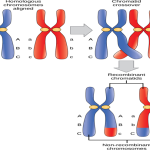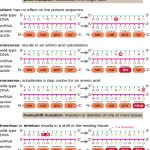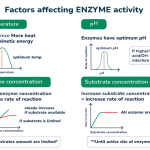Chromosomes are essential nuclear component that plays an important role in the transmission of hereditary information. Prokaryotic chromosomes are circular and have either DNA or RNA as principal chemical component. Eukaryotic chromosomes are fairly complex, thread-like structures and their molecular complexity is yet to be fully unravelled. Histone proteins are found in significant amount in higher plant and animal chromosome.1
Some cells contain large nuclei with giant or large-sized chromosomes at particular stages. The two types of giant chromosome are polytene chromosome and lampbrush chromosome.
1.1. Polytene chromosome:

Polytene chromosome are specialized type of interphase chromosomes. They are generated during early larval development when mitosis stops. The chromosomal DNA replicates several times without nuclear division and the resulting daughter chromatids do not separate but remains in side-by-side alignment. This phenomenon results in giant chromosome formation.
i. Discovery of Polytene chromosome:
Italian scientist E.G. Balbiani observed peculiar structures in the nuclei of certain secretory cells (Salivary glands) of Chironomus (Diptera). However, he could not recognize them as chromosome. In 1993, Theophilus Painter, Ernst Heitz and H. Bauer rediscovered them in Drosophila and branded them as chromosomes. Since these chromosomes had been discovered in the cells of salivary glands, they were called salivary gland chromosomes. Later, Koller renamed them as polytene chromosome due to the occurrence of many chromata (DNA) in them.2
ii. Location:
Polytene chromosome are giant chromosomes common in the salivary glands of certain dipteran larvae such as flies (E.g. Drosophila), mosquitoes, and midges (Chironomus). These polytene chromosomes may also be found less significantly in Malpighian tubules, rectum, gut, foot pads, fat bodies, ovarian nurse cells, etc.
iii. DNA content:
Polytene chromosomes have high DNA content. A polytene chromosome of Drosophila (in salivary gland) has about 1000 DNA molecules arranged side by side. Other Dipteran insects have more DNA. For example, in polytene chromosome of Chironomus, 1600 DNA molecules are present.
iv. Morphology:
Polytene chromosomes are mostly visible during interphase and prophase of mitosis. They are long, sausage-shaped and marked by swellings and cross striations (transverse bands). Their characteristic feature is represented in a series of dark transverse bands alternating with clear zones called interbands. About 85 per cent of DNA in polytene chromosomes is present in bands and the rest 15 per cent in interbands. The crossbanding pattern of each polytene chromosome is a constant characteristic present within a species. Hence, it helps in chromosome mapping during cytogenetic studies. Chromosome puff or Balbiani rings are the swellings of bands of polytene chromosomes where DNA unfolds into open loops as a consequence of intense gene transcription.
1.2. Lampbrush chromosome:
Lampbrush chromosome are specialized giant chromosome that occur at the diplotene stage of meiotic prophase in the primary oocytes of all animal (female) species.

i. History of Lampbrush chromosome discovery:
Lampbrush chromosome were first discovered by the pioneer cytologist Walther Fleming in 1878. He discovered them in the course of his studies on the development of ovarian eggs(oocytes) of amphibia and fish. He published his observations in 1882. Similar structures to those found by Flemming were also seen by Rabl (1885) in oocyte nuclei of the neotenic urodele Proteus and Hall (1890) in oocyte nuclei of chicken. However, it was Ruckert (1892) who first provided evidence that these structures are chromosomes. The term ‘lampbrush’ was attributed to these chromosomes because the chromosome looked like the brushes which were used for cleaning the glass chimneys of old-fashioned paraffin or kerosene lamps.3
ii. Location:
Lampbrush chromosome is present in the oocytes of both vertebrates and invertebrates. They have been described in Sagitta (Chaetognatha), Sepia (Mollusca), Echinaster (Echinodermata) and in several species of insects, shark, amphibians, reptiles, birds, mammals(human).
iii. Morphology:
Lampbrush chromosomes are diplotene bivalents. They consist of two axes, connected at the chiasmata, and the loops extend on both sides of the axes. The axes of a lampbrush chromosome consist of a series of dense granules, 0.25-2.0 micrometre in diameter and 1-2 micrometre apart. These granules are referred to as chromomeres. Few chromomeres have no loops attached to them, other bear multiple pair of loops. The loops extend at their maximum for between 5 and 50 micrometres from the axis and occasionally more. Other distinctive structures are the spheres or spherical bodies 7-10 micrometre in diameter that are not paired unlike the loops. There is only a single sphere per chromosome. They contain RNA polymerase II, as well as several other proteins for polymerase II transcription.
1.3. Significance of Giant chromosomes:
- Lampbrush chromosomes are involved in the synthesis of RNA and proteins needed for embryonic development.
- Each locus in lampbrush chromosome codes for RNA.
- Each loop is believed to represent one long operon consisting of repetitive cistrons to meet high rate of synthesis.
- Polyteny generally arises in tissues, organs and at developmental stages when there is need for the rapid development of an organ.
- Polytinization helps the organization to conserve energy during developmental phase by eliminating cell growth phase.
1.4. Comparison between Polytene and Lampbrush chromosome:
| Polytene chromosome | Lampbrush chromosome |
| Polytene chromosome occurs in the salivary glands of dipteran insects. | Lampbrush chromosome are found in the oocytes of vertebrates except for mammals. |
| They are comparatively smaller than lampbrush chromosome. | They are comparatively larger than polytene chromosome. |
| They are visible during the interphase and prophase stage of mitosis. | They are visible during diplotene stage of mitosis. |
| They contain intricate banding pattern with puffs. | They contain condensed axis with lateral loop. |
| Their functional state differs on the basis of development stage. | Each loop of the lampbrush chromosome functions as a long operon. |
REFERENCE
- S.C. Rastogi. Cell and Molecular Biology. Third edition. New Age International Publishers
- Dr. P.S. Verma, Dr. C.K. Agrawal. Cell Biology, Genetics, Molecular Biology, Evolution and Ecology. fourteenth. (Bharatnagar S, Pradhan S, eds.). S.CHAND & COMPANY PVT.LTD.; 2016.
- Harold G. Callan. Molecular Biology, Biochemistry and Biophysics. First edition.; 1986.






